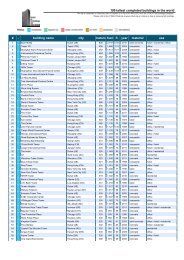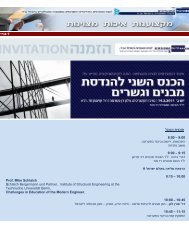צמנט רגיל צמנט : מסמך זה הוא הצעה בלבד מכון התקנים הישראלי
צמנט רגיל צמנט : מסמך זה הוא הצעה בלבד מכון התקנים הישראלי
צמנט רגיל צמנט : מסמך זה הוא הצעה בלבד מכון התקנים הישראלי
Create successful ePaper yourself
Turn your PDF publications into a flip-book with our unique Google optimized e-Paper software.
ועדה 10601EN 197-1:2011 (E)Cement conforming to this standard, termed CEM cement, shall, when appropriately batched and mixed with aggregateand water, be capable of producing concrete or mortar which retains its workability for a sufficient time and shall afterdefined periods attain specified strength levels and also possess long-term volume stability.Hydraulic hardening of CEM cement is primarily due to the hydration of calcium silicates but other chemical compoundsmay also participate in the hardening process, e.g. aluminates. The sum of the proportions of reactive calcium oxide(CaO) and reactive silicon dioxide (SiO 2 ) in CEM cement shall be at least 50 % by mass when the proportions aredetermined in accordance with EN 196-2.CEM cements consist of different materials and are statistically homogeneous in composition resulting from qualityassured production and material handling processes. The link between these production and material handlingprocesses and the conformity of cement to this standard is elaborated in EN 197-2.NOTEcement.There are also cements whose hardening is mainly due to other compounds, e.g. calcium aluminate in calcium aluminate5 Constituents5.1 GeneralThe requirements for the constituents specified in 5.2 to 5.5 shall be determined in principle in accordance with the testmethods described in EN 196 unless otherwise specified.5.2 Main constituents5.2.1 Portland cement clinker (K)Portland cement clinker is made by sintering a precisely specified mixture of raw materials (raw meal, paste or slurry)containing elements, usually expressed as oxides, CaO, SiO 2 , Al 2 O 3 , Fe 2 O 3 and small quantities of other materials. Theraw meal, paste or slurry is finely divided, intimately mixed and therefore homogeneous.Portland cement clinker is a hydraulic material which shall consist of at least two-thirds by mass of calcium silicates(3CaO ⋅ SiO 2 and 2CaO ⋅ SiO 2 ), the remainder consisting of aluminium and iron containing clinker phases and othercompounds. The ratio by mass (CaO)/(SiO 2 ) shall be not less than 2,0. The content of magnesium oxide (MgO) shallnot exceed 5,0 % by mass.Portland cement clinker incorporated in sulfate resisting Portland cement (CEM I) and sulfate resisting pozzolaniccements (CEM IV) shall fulfil additional requirements for tricalcium aluminate content (C 3 A). The tricalcium aluminatecontent of the clinker shall be calculated by Equation (1) as follows:whereC 3 A = 2,65 A – 1,69 F (1)A is the percentage of aluminium oxide (Al 2 O 3 ) by mass of the clinker as determined in accordance with EN 196-2F is the percentage of iron (III) oxide (Fe 2 O 3 ) by mass of the clinker as determined in accordance with EN 196-2.NOTE It may happen that a negative C 3A value is obtained from the calculation. In this case, the value 0 % should be recorded.A test method to determine the C 3A content of clinker from the analysis of a spot sample of cement is currently under development byCEN/TC 51. Until this method is available, the C 3A content should be directly measured on the clinker. In the specific case of CEM I,it is permissible to calculate the C 3A content of clinker from the chemical analysis of the cement. The minimum frequency of testingand the use of alternative methods for the direct or indirect evaluation of C 3A should be included in the factory production control (seeEN 197-2). A typical frequency of testing is two per month in routine situations.10
















